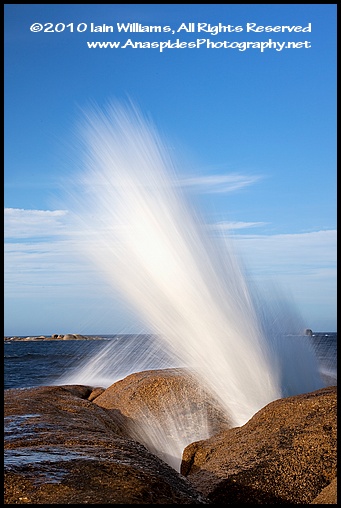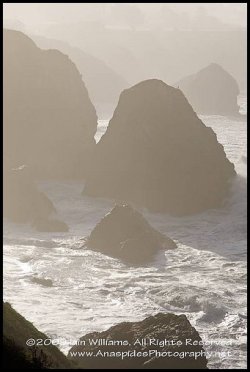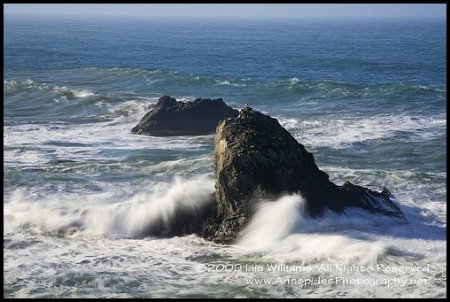Explosive Blowholes at Bicheno, Tasmania
 Wednesday, March 31, 2010 at 11:43PM
Wednesday, March 31, 2010 at 11:43PM  Recently I travelled to the east coast of Tasmania to a small coastal town called Bicheno. One of the attractions to this town in a blowhole located adjacent to the ocean. The geology of Bicheno is predominately massive granitic batholiths dating to the Devonian Period around 400 million years ago. Over geologic time the granite has become weathered and joints have developed within the rock. These joints are preferentially eroded by wind, water, waves and salt. In some areas these weathered joints are close to the tidal range of the ocean and seawater travels into the joint/crack as ocean swells wax and wan with the tides. The resulting feature is a blowhole in which seawater is propelled through the fissure to become highly compressed at the end of the crack resulting in an explosion of water.
Recently I travelled to the east coast of Tasmania to a small coastal town called Bicheno. One of the attractions to this town in a blowhole located adjacent to the ocean. The geology of Bicheno is predominately massive granitic batholiths dating to the Devonian Period around 400 million years ago. Over geologic time the granite has become weathered and joints have developed within the rock. These joints are preferentially eroded by wind, water, waves and salt. In some areas these weathered joints are close to the tidal range of the ocean and seawater travels into the joint/crack as ocean swells wax and wan with the tides. The resulting feature is a blowhole in which seawater is propelled through the fissure to become highly compressed at the end of the crack resulting in an explosion of water.
LEFT: The power of water is seen as it explodes from a small fissure in the rock at Bicheno, Tasmania
Acquiring an image that is somehow different to the many images taken at this popular spot is difficult. When I was on location there was strong late afternoon light; the light was golden but still rather intense. To obtain a slow shutter speed and cause the water to appear silky I decided to use my Singh-Ray Vari-ND filter. This filter has a changeable dial that allows you to "dial in" the denisty you require based on tyhe intensity of sunlight.
It was quite a bit of fun timing the water explosions to the swells and I can only imagine how much more powerful the explosions would have been if there was a strong swell running.
 Traditional approach
Traditional approach
Nearly everyone uses colour these days; to try and create something a bit different I decided to switch my Canon 1DsMK3 to monochromatic and see what I could achieve in traditional black and white. Unfortunately daylight was rapidly become dusk and I didn’t have too much time to think creatively before the light dropped below the horizon. I believe the area holds some promise, so maybe next time!
LEFT: Black and white is not dead. Often the traditional approach to photography is a good idea as shown in this black and white of the blowhole at Bicheno, Tasmania.
 Australia,
Australia,  Bicheno,
Bicheno,  Black and White,
Black and White,  Blowhole,
Blowhole,  Ocean Swells,
Ocean Swells,  Tasmania,
Tasmania,  Tourism,
Tourism,  Water,
Water,  Water Compression in
Water Compression in  Tasmania Australia
Tasmania Australia 



